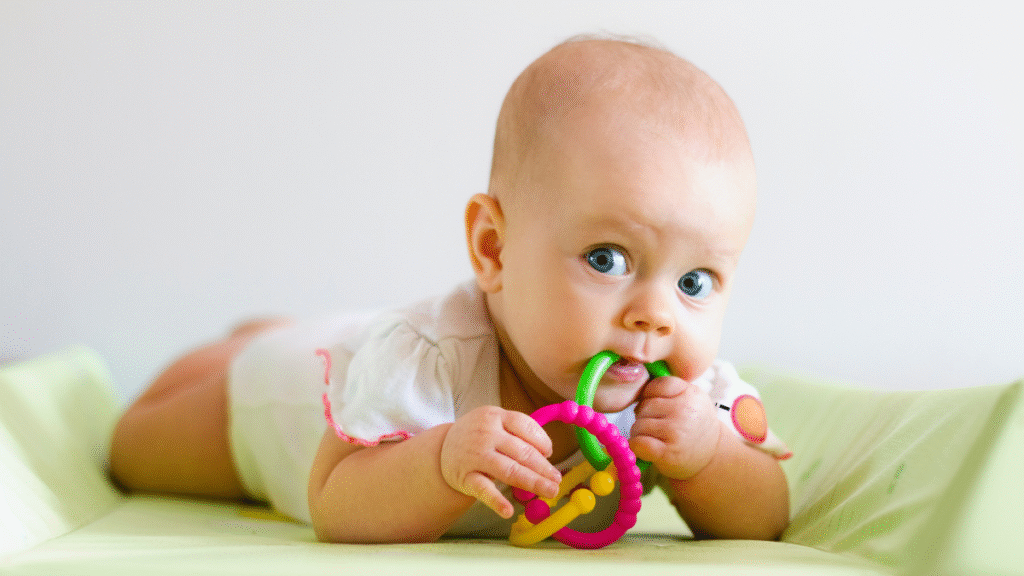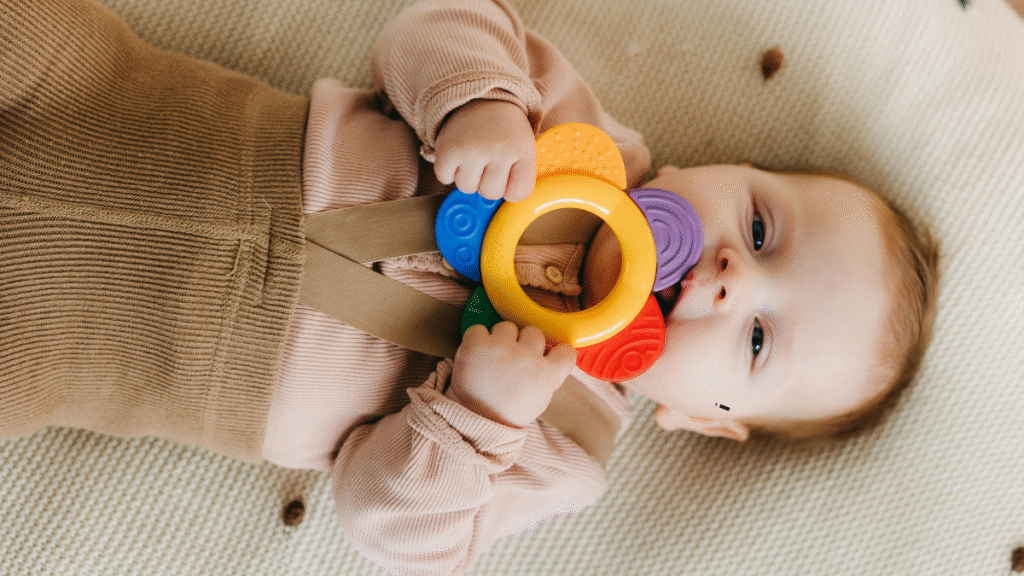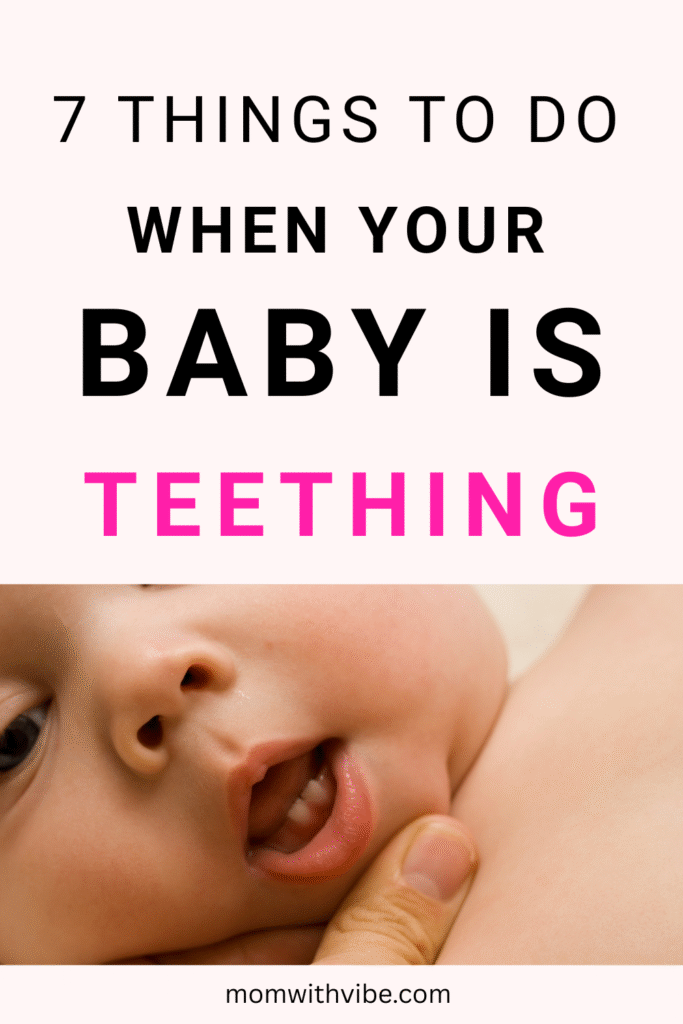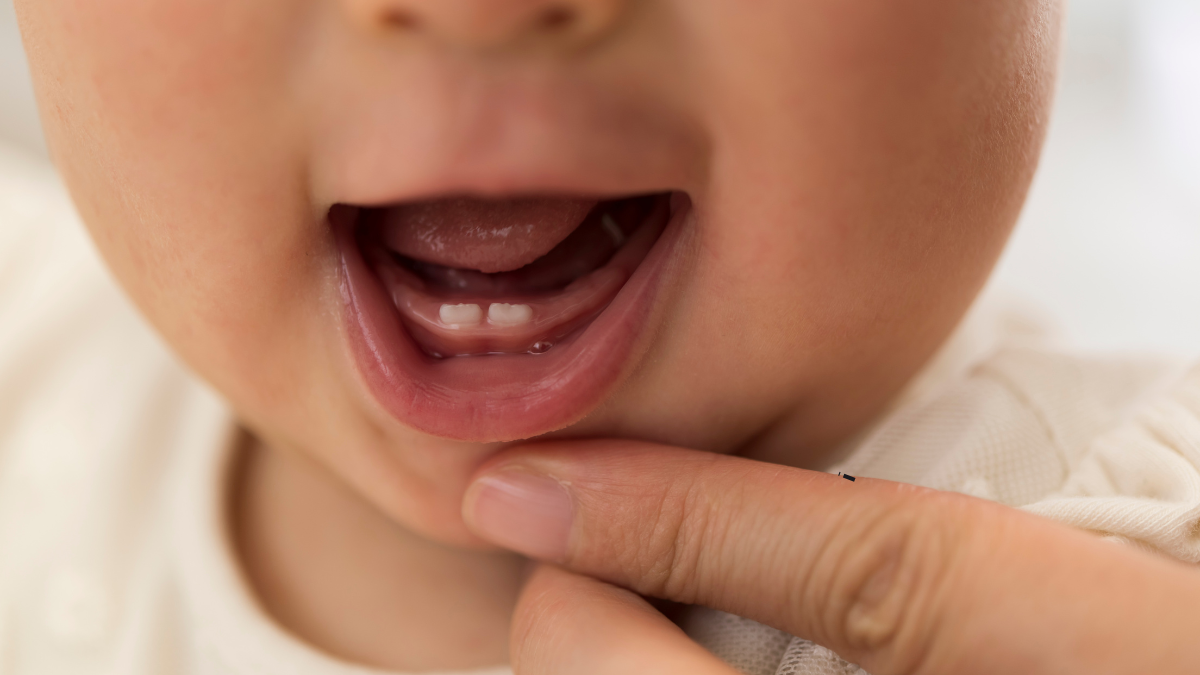Teething is considered a rite of passage by which every baby passes; however, it does not help in making the process less painful to them (and to you too!). With those early teeth starting to come through, you and your baby may find yourself dealing with a plethora of symptoms, such as drooling and irritability to sleepless nights and sore baby gums. It will be all right though, there are a lot of ways you can make it easier on your baby and help them out of this stage. The following seven tips will help you out with teething.
1. Give a Teething Ring or Toy
Most parents include teething rings in their teething survival kits. Such toys are meant to be chewed on and they help in soothing sore gums. There are many different types of teething toys, including plain rubber rings, to all filled with water so you can freeze them to make them extra cool. Cold teething rings are a miracle hit as they dull the gums to some degree and alleviate the pain in your baby.
One of the major designs to consider is the Sophie la Girafe teething toy. The reason many parents prefer it is its easy hold and soft feel that calms infants and toddlers as well as the non-toxic nature of the materials used. Also, there are parents who prefer those which are free of BPA, making them completely safe for babies to chew on, thus avoiding the risk of any bad substances in their babies.
Example: In case your baby is fussy or acting uncomfortable, you may want to offer him a chilled teething ring. You may discover that your baby will calm down and feel happy after only a few minutes.
Note: Make sure that the teething toy is not contaminated, and it does not have cracks or small attachments that may cause choking.
Related: 10 Reassuring Signs Your Baby Is Doing Just Fine
2. Rub Their Gums with Gentleness
A simple massage is sometimes all that is required. Your baby will also enjoy the comforting pressure that you can give him by softly rubbing your baby’s gums with a clean finger. This remedy will alleviate some of the pain inflicted by the teething process. The extra pressure will relieve the pain and help your baby to forget about the discomfort.
Example: In case your baby is especially fussy, massage his or her gums for a minute or two and then give him a teething ring or toy. This added comfort will enable them to feel more comfortable.
Hint: Please ensure you thoroughly wash your hands before touching your baby’s gums so as to ensure you do not introduce any bacteria into their mouth.

3. Take a Cold Washcloth
A cold washcloth may serve the purpose in case your baby is not attracted to a teething toy. Just wet a dry washcloth slightly with cold water, and give it to your baby and let him chew on it. It can numb their gums and reduce the pain temporarily due to the cold sensation.
An example would be having some babies like the feel of a washcloth compared to plastic or rubber teething rings, making this alternative a good solution. You may also flavour it a bit by dipping the washcloth in fruit juice or milk and then freezing this washcloth so that your baby is not bored.
Pro-tip: As your baby chews on a washcloth, make a point to watch them at all times to prevent any chances of your baby swallowing some remnants of fabric.
4. Try Medicine or Teething Gel
Teething gels and over-the-counter pain relief drugs can help soothe your teething baby, though they are of little use when the pain feels insufferable. Most teething gels contain natural ingredients such as chamomile, but others contain limited numbing agents such as benzocaine or lidocaine. Nevertheless, you should always discuss with your pediatrician about any over-the-counter product usage, as they need to be safe and suitable for the age of your baby.
Example: A topical teething gel (such as Orajel Baby) may be used to ease pain in a baby whose sleeplessness or inability to eat is affecting him due to the pain. You just need to make sure that you follow the instructions on dosage.
Hint: You can also seek advice with your pediatrician regarding such infant pain relievers as acetaminophen or ibuprofen, which may be used to handle more serious pain.
Related: 10 Symptoms Of Egg Allergy In Babies
5. Stick Their Mouth Clean
During the teething period, your baby might experience random cases of excessive drooling that may irritate its skin or gums. It can be kept dry by regularly wiping their mouth with a clean cloth to avoid the discomfort caused by drool. Besides wiping them after they eat, ensure you clean their gums as well after eating to avert any bacteria that may build up on the gums.
Scenario: In case your baby is drooling excessively, then use soft bibs to clean the saliva. Always ensure that you change the bib to avoid irritating your baby when their skin becomes wet. After feeding, you can wipe them with a soft, wet cloth on the gums.
Tip: When you see your baby’s skin getting irritated or red due to drool, use a gentle, baby-safe moisturizer to help prevent skin chafing.
6. Serve Cold Foods (If They Have Started Solids)
Once your baby begins to eat solids, cold foods may be an excellent method to reduce the pain of teething. Cooled fruit purees, yogurt, and even a bit of cucumber can contribute to cooling down the gums of your baby and giving them some extra care. One could also freeze fruit (e.g., berries, watermelon) to produce a cool and fun snack. Make sure that you cut your fruit into small pieces or use mesh feeders to avoid any choking.
The example here could be similar to freezing some pieces of mango or banana—this can be relaxing to your baby’s gums. The cold will numb the area, and the soft texture will ensure that they can eat without discomfort.
Hint: Do not feed your baby any hard, crunchy food which could be a choking hazard.

7. Give Extra Affection and Cuddles
The process of teething is emotionally exhausting for your baby, so sometimes, the answer is just to provide some additional comfort. Babies are teething, and therefore they may feel that they need more attention and cuddles. Rocking the baby or even a few more minutes in your embrace can go a long way. Your baby might be fussier than others, and you may need to offer them physical comfort to make them feel safe and loved during this period.
Example: In case your baby is more irritable at the end of the day, take him/her in your hands and gently rock him/her to sleep. A warm bath may also work to relax them as they sleep.
Tip: Additionally, your baby can be helped to calm down before naps or bedtime by singing softly or singing sweet songs to offer him or her emotional comfort.
Conclusion
Even though teething is a difficult, transitional period, there are a few ways in which your baby can go through it much easier, as well as you. Soothing teething rings, cold foods, and lots of cuddles can work wonders towards alleviating the discomfort for your baby. Do not be afraid to call your pediatrician when you think that the pain is too severe or if you do not know what measures to take.
For more detailed research on teething and how to go about relieving the pain, look here at the guide to teething by The American Academy of Pediatrics.
Frequently Asked Questions (FAQs)
Q1: How does my baby indicate that he/she is teething?
A1: The typical symptoms related to teething are drooling, irritability, reddened or painful gums, biting, or chewing of objects, and sleeping problems. Other babies can even refuse to eat or demonstrate discomfort when their mouths are touched.
Q2: At what age do people develop the first teeth?
A2: Teething usually starts at the 4th to 7th months, but some infants start at earlier or later ages. The bottom front teeth (lower central incisors) are normally the teeth which come into the mouth first, followed by the upper front teeth.
Q3: Is it bad to use benzocaine-based teething gels?
A3: Yes, it is advised that teething gels that contain benzocaine should not be used on children below age 2 since they have a risk of a severe but rare disease known as methemoglobinemia, which could diminish low oxygen levels. Pediatricians recommend never using teething gels without consulting them.
Q4: Does teething lead to fever?
A4: Teething is not usually associated with high fever although it might make the little one irritable and feel slightly uncomfortable. In case the temperature of your baby exceeds 100.4°F (38°C), it is possible that other factors cause fever, and you need to call your pediatrician.
Q5: What is the duration of the teething process?
A5: Teething may start as early as 4-6 months and may last until your baby is two years old. By 3 years of age, most babies will have all their primary (baby) teeth, but this may vary with individual cases.
Q6: Do natural remedies exist to solve teething problems?
A6: Other parents choose homeopathic or herbal measures, such as a glass of cooled chamomile tea (in small quantities) or herbal teething rings. Nevertheless, consider speaking to your pediatrician first before attempting any homeopathic remedies as these may be harmful to your baby.
Save the pin for later




